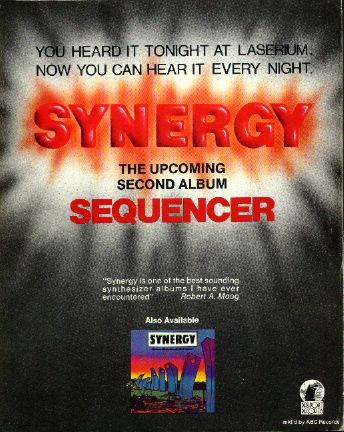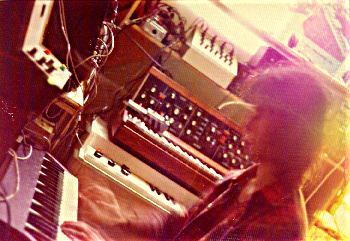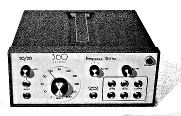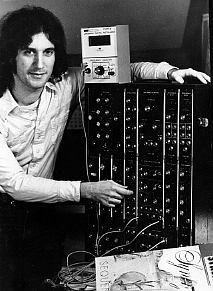|

|
|
|
"Sequencer" was started
during the summer of 1975 shortly after the release
of Electronic Realizations for Rock Orchestra.
House of Music, where the first Synergy album had
been recorded, had been a 16 track facility. During
the summer of 1975 they went through a major
upgrade to 24 tracks with a new MCI JH-500 console
and JH-24, 2 inch analog tape machine with dbx
noise reduction.
During the weeks after I
returned from Europe after having worked on
Nektar's "Recycled" album, Marty Scott, president
of Passport Records had been lobbying for a Synergy
track that radio might play more easily than the
long and demanding tracks on "Electronic
Realizations". He came up with a few suggestions
for remakes of previous instrumental hits. Though
there were a number of different songs suggested, I
remember that one was "Telstar" and another was
"Classical Gas". I picked "Classical Gas" and used
that as an opportunity to take House of Music's new
24 track installation on a shakedown
flight.
|

record
company publicity photo taken in the studio control
room during the recording of Sequencer.
|
|
At around the same time I
took delivery on some new Moog equipment. Though
the new synthesizer modules weren't anything
different than what had been available for a few
years, the new 952 duophonic keyboard was a
departure. Instead of the monophonic
one-note-at-a-time keyboard that I had been using,
this one put out two sets of control voltages and
triggers corresponding to the highest and lowest
notes pressed on keyboard. It doesn't seem like
much, but the ability to play two notes at a time
was a big jump in electronic music production.
There is a lot of unpredictable interaction between
synthesized sounds at different pitches, even when
the sounds are from the same patch. When every
sound is done one-at-a-time there were always a lot
of surprises, backtracking and re-doing when the
arrangements began to emerge on the multitrack
tapes. The 952 allowed for a tiny bit of previewing
(or pre-hearing) of how some simple two-part sounds
and patches would work together.
|
|

|
"Classical Gas", recorded
primarily in August of 1975 was used as a test of
the new equipment. It went so well, that a nearly
complete reference mix, missing some of the
percussion, was included on the British release of
"Electronic Realizations" on Sire Records/Phonogram
UK later that fall.
A side project that
contributed to the work on what became "Sequencer"
also occurred during the summer of 1975. The
Planetarium laser show "Laserium" had been using
some of the music from "Electronic Realizations".
After some meetings with the show's developers (at
the Algonquin Hotel in New York, sitting near the
famous "Round Table"), I was asked to develop
Synergy music for a projected show with a working
title of 'Laserium UFO'. Though the Laserium show
never happened, a bit of the music and sonics
developed for it lived on as the 'rainforest/UFO'
section of "Sequence 14".
|
|
Another piece that evolved
during the summer of 1975 was "Chateau". The themes
had been around in various forms since the writing
for "Electronic Realizations". At the sessions in
France for the Nektar "Recycled" album, I had the
usual amount of spare time while the other guys
worked on their overdubs. I had time to refine
those themes into the basic structure at a
beautiful grand piano in the studio. It was one of
the few times that I developed a piece on piano
rather than working directly with electronic
instruments. Since the Nektar sessions were at the
Chateau d'Herouville Studios in France (the Honky
Chateau of Elton John fame), the unnamed piece had
a working title of 'Chateau'. The name stuck.
Work on writing "Sequencer"
got under way in earnest during the fall of 1975
again using a Tascam 3324 4 track recorder at home
to do demos of the pieces to test out patches and
arrangements. Metronome click tracks from these
demos were later dubbed onto the 24 track master to
serve as a basis for rerecording the music in its
final form. Ideas came and went, but eventual the
shape of the album took form.
|

writing
in the home studio, autumn of 1976
|
|
Studio recording got going
during January 1976, back at House of Music. Both
the recording and synthesis equipment was better
than what had been available a year earlier during
"Electronic Realizations". With the new Moog
modules and filter banks I could synthesize a whole
new class of string and brass sounds. That meant
that the Mellotron was retired and not used on
"Sequencer" (I have used it on other artists'
recordings, but it hasn't appeared again on any
further Synergy recordings so far). With the new
equipment I was also more confident as an engineer
producer, and committed more echoes and effects to
the multitrack tape instead of waiting to make
decisions during the mix. A lot of tape delay
effects were done using a varispeeded MCI JH-110
stereo 2 track recorder, an antique (even back
then) Ampex 300 full-track mono machine, and an
early Eventide model digital delay line. This also
made the mix a lot easier to perform
later.
"S-scape" had a couple of
interesting influences. The inspiration for the
opening power chords came directly from The Who and
Pete Townshend. The light pulsing string
underlayment happened after seeing Woody Allen's
"Love and Death" where he used Prokofiev's "Troika
from Lieutenant Kijé" theme. I liked the
general approach and rolled it into a few bars of
the opening section. We had one mishap during the
recording of this track. At one point the MCI 24
track recorder needed some service, as many new
recorders do in their first few months. After the
servicing was done, the tape heads were plugged in
wrong. The erase head connectors for the tracks 1-8
and tracks 9-16 blocks were reversed. When I
punched in to record new tracks on tracks 9-16,
things started to get wiped out on 1 through 8, and
nothing got erased on 9-16 though a jumble of
sound-over-sound overdubs started to pile up on the
new tracks. It took a little while to figure out
what was going on and correct it. And, of course
the erased and damaged tracks had to be rebuilt and
repaired. You can hear some subtle changes in the
patches and printed echoes during the opening 90
seconds or so.
"Chateau" didn't have any
major problems in the recording. There was an idea
to process the next to the final sequence of the
piece with filtering and scratchy sounds to make it
sound like an old 78 RPM shellac disk (early shades
of rap and hip-hop?). But, the effect never sounded
quite the way I imagined it and the idea was
dropped during the mix. Maybe we'll try it again
someday.
|
|
 "Cybersports" is a very sequence-intensive
composition. It was written with the imagery in
mind of the early video games like 'Pong' and such
which had been out just a couple of years by 1975.
The games were still extremely primitive during
those days, but for anyone involved with
electronics or mainframe computer graphics then, it
was obvious how things would evolve. I wanted to
create some sort of early anthem for the
electronics gaming age. I guess it's happened by
now. A sound I often get asked about is the
metallic cascading downward spiraling wall of sound
that punctuates several musical themes. It was more
of an effects patch than anything. A rather plain
and simple downward chromatic sequence was run
through a DDL feedback looped through the 360
Systems analog pitch changer set to lower pitch.
Since each echo iteration looped lower and lower,
the echoes cascade down. The analog pitch shifter
produced a lot of ring modulation artifacts, unlike
today's super-clean digital pitch shifters, so the
metallic tonality really built up into quite a
sound.
"Cybersports" is a very sequence-intensive
composition. It was written with the imagery in
mind of the early video games like 'Pong' and such
which had been out just a couple of years by 1975.
The games were still extremely primitive during
those days, but for anyone involved with
electronics or mainframe computer graphics then, it
was obvious how things would evolve. I wanted to
create some sort of early anthem for the
electronics gaming age. I guess it's happened by
now. A sound I often get asked about is the
metallic cascading downward spiraling wall of sound
that punctuates several musical themes. It was more
of an effects patch than anything. A rather plain
and simple downward chromatic sequence was run
through a DDL feedback looped through the 360
Systems analog pitch changer set to lower pitch.
Since each echo iteration looped lower and lower,
the echoes cascade down. The analog pitch shifter
produced a lot of ring modulation artifacts, unlike
today's super-clean digital pitch shifters, so the
metallic tonality really built up into quite a
sound.
|
|
"Paradox" which is a pairing
of the Largo from Dvorak's New world Symphony and
Ralph Towner's "Icarus" was suggested by Passport
Records president Marty Scott. "Icarus" was another
shot at using a familiar instrumental piece in
order to generate some radio play. The "Largo" was
a favorite of mine. Marty suggested that they might
be combined, and by putting them in the same key
and fooling with the timings a little, an
arrangement that tied the two of them together
evolved. Incidentally, Marty later went on to head
a record label called Paradox.
"Sequence 14" is based on a
14 step sequence, stored in the Oberheim DS-2
digital sequencer and used as the basis for the
entire piece. The techniques used for the recording
are all pretty straightforward multitrack
overdubbing. As mentioned earlier, the quiet
rainforest "scene" in the middle is a segment that
was initially developed for a never-produced
Laserium planetarium laser light show. The scherzo
movement at the very end of the entire piece was
much longer at one time, too long, in fact. I was
bold enough to do a massive editing job right on
the 2 inch 24 track tape. When that one minute
segment played back for the final mix, I think
there was more editing tape than regular mylar
backing on the multitrack. I'm guessing that there
are easily 35 or 40 razor blade edits flying by. If
only there had been digital editing
then...
The percussion on "Sequencer"
is still quite mild, made up of the limited
transient dynamics that the analog synthesizers
could produce back then. In spite of that, I called
on Ron Howden, the drummer with Nektar, to join me
in the studio for a day of incidental electronic
percussion. Ron and I both played parts on the Moog
keyboard, but his years of experience as a
percussionist brought a perspective to the record
that I wouldn't have been able to do
myself.
The mix was done at House of
Music using a retrofitted automation system in MCI
console. The computer mix system was called
Memories Little Helper and some closeup photos of
it appeared in the artwork for the album cover.
Mixing was done to 1/4 inch analog tape with dbx
noise reduction. The Quad phenomenon had died down
a lot since "Electronic Realizations" and due to
the compromises in sound quality and dynamic range
I decided to opt for a conventional stereo mix.
Mastering to disk was performed by George Marino at
Sterling Sound in New York.
|
|
During the course of
recording "Sequencer", a few things happened that
would influence my later projects. One was that I
began getting involved with the new microprocessors
that had been unleased to electronic hobbyists the
previous spring with a cover story on building your
own computer in the January and February 1975
issues of Popular Electronics. I gravitated to the
MOS Technologies 6502 processor rather than the
Intel 8080 in the Popular Electronics article.
Nevertheless, it got a computer (of sorts) back
into my hands for the first time since I had
graduated college. The machine code that I learned
for that processor was the same that was used in
the Apple I computer which appeared later that
year, and the Apple II in 1977.
Another was that I was
travelling to upstate New York to throw in my two
cents to the development of the Polymoog. One of
the first prototypes of that new instrument joined
me on tour with Nektar right after the completion
of "Sequencer" in the spring of 1976. It would play
a much bigger role in my next project, Cords and on
the first Peter Gabriel album and tour.
Sequencer was launched at a
joint press event held at the Atlantic Records
Recording Studios in New York City on May 21, 1976.
The event announced both the Sequencer album
release and the new Moog Polymoog synthesizer. It
was at that event that I took a phone call from
producer Bob Ezrin arranged by Hamilton Brosious of
AudioTechniques, a major power in the the recording
studio business (and later one of the founders
behind digibid.com). That phone call was the
invitation from the Bob to work on Peter Gabriel's
upcoming first solo album.
|

|
|